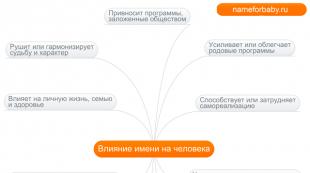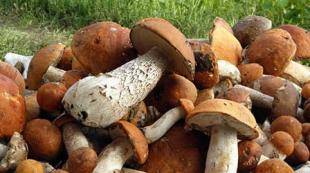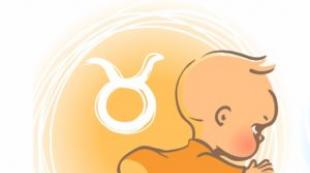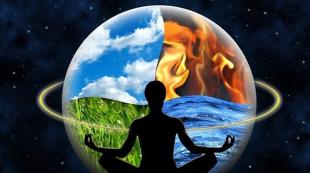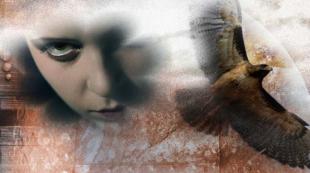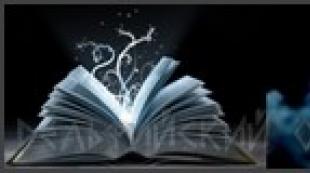Presentation of the beauty of God's world Sunday school. Presentation catalog
"The beauty of God's world"
Senior age group
Target:
Formation of moral consciousness and behavior;
Development of moral experiences and feelings.
Main tasks:
Tutorials:
To begin to reveal to children the basic ideas of Orthodoxy about the structure of the world and its Creator;
Introduce children to the circle of the main Orthodox holidays and the spiritual and moral way of life of their people;
Give an initial idea of Orthodox church, familiarize children with the rules of conduct in the temple;
Continue to acquaint with Russian folk songwriting;
Develop and expand understanding of the meaning of folk proverbs; etc.
Educational:
To cultivate a sense of integrity, belonging to the living world, closeness, openness and trust in its Creator;
To teach a caring attitude towards plants and animals, respect for the environment;
Cultivate patience and organization; feelings of the beautiful and sublime, a feeling of reverence for the shrines;
To promote the desire of children to imitate the saint in the virtues of obedience to parents, humility, love for God, people and the Motherland;
To educate in children attentiveness and caring for relatives; etc.
Developing:
To promote the development in children of figurative perception, a sense of the beautiful and sublime;
To promote the formation of a spiritual and moral personality with an optimistic outlook on life, with a focus on the knowledge of God, forming the highest feelings;
Develop teamwork skills, teach children to do business together, together, harmoniously;
To promote the development in children of the habit of classes, useful activities, non-idle spending time;
To develop in children the ability to yield, negotiate, get along with other children and adults; etc.
The task of forming moral consciousness and behavior is implemented and integrated with all educational areas, especially: "Cognition", "Reading fiction", "Communication", "Socialization", "Music", " Physical Culture"," Artistic creativity.
Materials and equipment: computer, projector, presentation "Creation of the World", globe, illustrations "forest, sea, field, mountains", recording "Noise of the forest, birdsong", album sheet, gouache, brushes.
1. Six days of creation of the world
So, how is the creation of the world described in the biblical books? Let's look at each day step by step:
- Day 1 In Genesis, the beginning of creation represents the creation of the earth by God. The earth was empty, lifeless, lying in bottomless darkness, but on its surface there was water, over which God's Spirit hovered. Seeing that darkness covers everything around, God created light and separated it from darkness, thereby creating day and night.
- Day 2. Since the earth was lifeless, God needed to create the sky, which in "Genesis" is called "the firmament." The air space, according to God's plan, was to separate the water that is under the firmament from the water that is above the firmament, that is, in this way God delimited the near-earth and near-heaven space. The atmosphere of the planet was created.
- Day 3. The next creations of God are called land, seas and flora. Having collected all the water in certain places, God created the seas, and called the land that appeared land. The earth brought forth its fruits: greenery, grass that produced seeds, fertile trees, the seeds from whose fruits fell to the ground and grew again.
- Day 4. On this day the sun, stars and moon were created by God. These "lamps" were needed to control day and night, as well as to determine days, years and times. According to God's idea, "lamps" were also supposed to be conductors of various signs.
- Day 5. To see how God created the world, just read the description of the fifth day in Genesis. It was marked by the creation of the kingdom of fish, reptiles and birds, which God commanded to be fruitful and multiply, filling the water and the sky.
- Day 6. The last day of the creation of the world was devoted to the creation of the animal world and man himself. When God created "cattle, reptiles and beasts of the earth", he decided to put his crown of creation - man - over all this. How did God create man? He made him in his image and likeness from the dust of the earth, blowing into his face the Breath of Life. Having created Paradise in the east, he settled a man there and ordered him to cultivate and keep the Garden of Eden, to give names to all animals and birds. How did God create woman? When a man asked God to create a helper for him, God put him to sleep and, taking a rib out of his body, created a woman. The man clung to her with his soul and since then has never parted.
Thus, within six days God conceived and created the earth, animals and people. God blessed the seventh day as a day off, on which, according to Christian tradition, one should not engage in physical labor, but should be dedicated to God.
The whole Earth is a huge garden:
Here the grass caresses the eye,
Trees here, bushes there.
And, of course, flowers.
2. Journey to the meadow. The game "Who is there hiding in the grass."
Children pass the ball around in a circle and name insects, flowers.
3. Walk in the forest. Game "Forest Wonders".
Children pass the ball to each other and name trees, animals and birds.
4. Physical education minute.
Hands raised and shook -
These are the trees in the forest.
Hands bent, brushes shaken -
The wind knocks down the dew.
To the sides of the hand, gently wave -
The birds are flying towards us.
How they sit down, we will also show -
Hands crossed back.
(Children stand freely on the carpet. Movements are performed in accordance with the text).
5. Immersion underwater. Game "Underwater world".
Dive into the depths of the sea -
Whom you will not find there!
You could easily find
Jellyfish, shrimps, crabs, fish.
Children name sea creatures.
6. We climb the mountains. Children look at photographs of mountain vegetation and animals.
7. The circle of the sun is golden ....
The field… The forest is green.
How beautiful is the world around
Created by God.
Children draw their impressions, pictures of nature.
8. Bottom line.
Good and Evil
There is in our world.
Kindness of all people
We can't count.
But all the best
God - He is Good!
Presentation from the cycle "The Sacred Biblical History of the Old Testament" about God's creation of the world and man according to the textbook of Archbishop Benjamin (Pushkar), Metropolitan of Vladivostok and Primorsky (3.9 MB, pptx).
Additional download addresses:
All presentations in this series can be downloaded or transferred to your accounts (either individually or as an archive) on Yandex.Disk and [email protected]
Scans of some slides. An enlarged image opens in a separate window by clicking on the picture:
Presentation slide content.
Slide 2. James Tissot. world creation. God's creation of the world and man
The Book of Genesis→
God is the Creator→
angelic world→
Material world→
Slide 3. Scroll. The Book of Genesis. This book is called so because it tells us about how “everything began to be that began to be”, i.e. how God called the visible world from nonexistence to existence.
Slide 4. Moses writes the book of Genesis. The author of this Holy Book is the great prophet and leader of the Jewish people Moses. Hidden text: He wrote this book in order to perpetuate the history of the origin of the world and the original fate of mankind, when oral traditions about this began to be distorted and even gradually disappear.
slide 5. The entire narrative of the book of Genesis, which contains 50 chapters, can be divided into three main and essential parts.
↓ First(1-3 ch.) tells about the origin of the world and the fall of the ancestors.
↓ Second(4-11 ch.) sets out the history of primitive fallen mankind, its death in the waters of the flood, reproduction and dispersion throughout the world of post-Flood mankind.
↓ In the third(12-50 ch.) contains the history of the life of the Jewish people.
Slide 6. Aivazovsky I.K. World creation. Chaos. God is the Creator of the world and man.
Slide 7. nature photography. Beauty, harmony, diversity… Hidden text: The world, considered in its external beauty and internal harmony, is a marvelous creation, amazing in the harmony of its parts and the wonderful variety of its forms.
Slide 8. space photography. "Cosmos" - beauty, order. Hidden text: Even the ancient Greek genius, contemplating a reasonable device in the universe, gave him the name kosmos (kosmos), which means beauty, order.
Slide 9. Cognition of the world - knowledge of the Creator. Hidden text: Knowing through telescopes and radio telescopes the vast depths of space and at the same time penetrating into the world of elementary particles, modern science sees on everything visible the seal of the invisible Supermundane Mind.
Slide 10. Icon "Trinity". Rev. Andrei Rublev, first half of the 15th century. Creator of the world and man - God. Hidden text: It is this Supra-Mundane or Divine Mind, which is revealed in the world and through the world to man, according to the Holy Bible, is not only the organizer of this world, but also its Creator.
Slide 11. bible book. The Holy Bible on its first pages tells us the secret of the origin of this visible world.
slide 12. Aivazovsky I.K. world creation. Time is a form of being of the material world. “In the beginning God created the heavens and the earth” (Gen. 1:1), says the chronicler Moses. Hidden text: In these few words, the truth, immense in its depth, is expressed that everything that exists in heaven and on earth, and therefore primitive matter, has its origin. The word "in the beginning" indicates that the world is not eternal, it is called from non-existence to being God in time, or rather, with time itself. There was no time before the appearance of the world, because time is a form of being of the material world.
slide 13. Photograph of Earth from space. The reason for the origin of the world is the will of God. Hidden text: God is the natural cause of the universe, and without Him nothing could have happened. The world could not come either from "accident" or from "spontaneous generation." It originated from the free decision of the will of the almighty God, who favored from non-existence to call the world to temporary existence.
Slide 14. This decision stemmed solely from the love and goodness of the Creator in order to give the creature the opportunity to enjoy these greatest properties of His Being.
slide 15. Gustave Dore. Creation of light. In the beginning was the Word, and the Word was with God, and the Word was God(John 1:1). And so “...He,” according to the divinely inspired psalmist, “said and it happened, He commanded and it appeared” everything (Ps. 32:9). Hidden text: According to the interpretation of the holy fathers of the Church, the creative Word of God must be understood as the Second Hypostasis of the Holy Trinity - the Son of God, through whom, in the words of the Evangelist John the Theologian, "everything ... began to be, and without Him nothing began to be that began to be" (Jn .1,3). Since the second verse of the first chapter of the book of Genesis speaks of the participation of the Holy Spirit in the creation, one can think that God acted in the creation of the world as the eternal Trinity.
slide 16.The world is created from nothing
. Hidden text: The creation of the world from nothing or from nothingness is one of the basic truths of the Christian faith. Although the Bible does not contain the word "out of nothing", but it is implied already on its first pages. This word was first introduced into use by the holy fathers and teachers of the Church, in opposition to the then dominant dualistic worldview of many pagan thinkers, who recognized, along with the eternal God, eternally existing matter, from which God then created various forms of the visible world. In turn, the pagan sages objected to the monistic view of the holy fathers and said that something cannot be created from nothing. St. Basil the Great, in response to their objection, explained that God did not create the world out of nothing in the literal sense of the word, but out of "His might." So we need to understand the word “out of nothing” in the sense in which the holy fathers used it. Since there is no change in God, one can think that the image of the world has always existed in His Mind. In other words, the idea of the world has always existed with God, but then, by His all-good will, it received its realization in time.
slide 17. Heavenly Forces (fragment of wall painting of St. Michael's Golden-Domed Cathedral in Kyiv). angelic world.
Slide 18. Collage - earth and sky. God created two worlds: heavenly, earthly. Hidden text: The Bible gives us very little information about the spiritual world. From the context of the entire Bible, the following idea of the spiritual or angelic world can be drawn.
slide 19. Priest Alexander Egorov. Powers of Heaven. The angelic world was created by God before the material world. Hidden text: The Lord Himself clearly tells us about this in the book of Job: “When the stars were (created), all My angels praised Me with a great voice” (Job 38:7).
slide 20. Angel Drawing. Angels are beings thinking, willing, feeling like people, but incorporeal.
slide 21. Gustave Dore. Angelic extravaganza ("Paradise Lost"). The number of angels is very great.
slide 22. Gustave Dore. "Lost heaven". According to their perfections, the angels are not the same and are divided into several degrees. The lowest of the angels is by nature superior to the most gifted man. Hidden text: The fate of the spiritual world is hidden from us, but one event known to us from the Holy Scriptures slightly reveals the secret of this world.
slide 23. Gustave Dore. "Lost heaven". All angels were created by God to be good. They lived in direct communion with God and were in a blissful state.
slide 24. Gustave Dore. "Lost heaven". And then one of the highest angels, named Dennitsa, proud of his perfections, left obedience to God ...
↓ ... became an evil devil (slanderer), Satan (an adversary) and dragged away many angels subject to him.
slide 25. Gustave Dore. "Lost heaven". Archangel Michael - the leader of the Angels who remained faithful to God ...
↓ ...thrown all the evil angels into hell, i.e. to a place where the saving grace of God is absent.
slide 26. Gustave Dore. "Lost heaven". Thus, immense pride, which does not allow even a shadow of humility and does not give room for repentance, has closed forever for fallen angels Kingdom of heaven…
↓ ... and cast them down into the hellish abyss, where they are kept in eternal bonds of spiritual darkness on the day of the Last Judgment.
slide 27. Photograph of Earth from space. Material world. The material world was created by God in six creative days or creative periods. Hidden text: The Hebrew word day (yom) - means not only our earthly day, but generally an indefinite period of time.
slide 28. Chiurlionis M.K. world creation. The first creative act of God- primary matter. ↓ From the original matter - ↓ all forms of being.
slide 29. Chiurlionis M.K. world creation. Initial state Moses calls the newly created matter:
↓ earth (Hidden text: because Earth was then formed precisely from this primordial matter)
↓ abyss (Hidden text: indicating by this its infinity and immensity for the human eye)
↓water(Hidden text: meaning by this the instability, mobility, rarefaction of primitive matter, in comparison with state of the art matter)
↓ invisible (Hidden text: in the sense of the absence of those specific features and qualities with which matter subsequently appeared, upon completion creative activity, and with whom it is observed now)
↓ unsettled (Hidden text: In the sense of the absence of those laws that so wisely and harmoniously determined her life later (“the earth was formless and empty” (Gen. 1.2))
slide 30. Chiurlionis M.K. world creation. There was darkness over the abyss of pra-matter. Hidden text: This expression of the writer of everyday life can be interpreted in the sense that this primary state of pra-matter is inaccessible to human knowledge. This substance is before the human consciousness as an "abyss", not explored and "in depth" and "in breadth".
. « And the Spirit of God hovered over the water"(Gen.1,2). Hidden text: With these words, the writer expresses the idea that the Third Hypostasis of the Holy Trinity - the Spirit of God - prepared this primordial substance for further creative Divine acts.
slide 31. Aivazovsky I.K. world creation. Hidden text: And from this ready-made, primordial, but still unorganized substance, further creation takes place, which took place in the course of six days, or periods, when the omnipotent hand of God, according to the sacred writer of the book of Wisdom of Solomon, creates the world "out of an unshaped substance" (Wisdom 11, eighteen).
"Additional educational program" - What is the effect? Effective component Expected results What is the result? Content component The essence of the activity. 5 min Answering questions. What tasks does the program solve? Protection of additional educational program. Representation of the program based on answers to questions. For what? Characteristics of children Duration of the implementation of the educational program Forms and mode of classes.
"Activity of a teacher of additional education" - Modernization of management. Sphere evolution additional education. Innovative scientific and methodological potential. Forms of presentation of the activities of organizations. Control result. The policy of modernization of additional education for children. Development innovation activities. Reforming the educational system.
"Electives" - A three-point scoring system is proposed. Presentation of educational products by students. Functions of extracurricular activities. Logical-semantic model. Multidimensional didactic technology. List of competencies. Criteria and performance indicators. Self-assessment of the level of mastery of skills. Pedagogical function of MDI.
"Additional education" - Integration of general and additional education. Work in the classroom. School education. School additional education. Primary education. Educational process. Models of organization of additional education of children in educational institutions. Additional education. Institutions for children. Variations on the theme of INTEGRATION…..
"Organization of additional education" - The content of the work. December. September. August. April. March. Additional education at school. January. May. clear and harmonious work all pedagogical system. February. Educational program of additional education of educational institution. November. Organization of additional education. June. Documentation. Cyclogram of the work of the organizer of additional education for children.
"Additional education program" - Table No. 1 "Forms of identification, fixation, presentation of results." Techniques and methods of organization educational process. It is possible to use the form as a reception. The plan for the implementation of experimental programs is heard and adopted by the Methodological Council. Evaluation of the effectiveness of the implementation of programs for additional education of children: a competency-based approach.
There are 13 presentations in total in the topic

























 Back forward
Back forward
Attention! The slide preview is for informational purposes only and may not represent the full extent of the presentation. If you are interested in this work, please download the full version.
The purpose of the lesson:
- Introduce students to works of religious art.
- To figure out Orthodox meaning concepts related to the lesson.
- The development of the aesthetic perception of "beauty" among schoolchildren as a phenomenon of spiritual significance.
- To form moral consciousness on the basis of Christian moral concepts.
- To develop the speech of students, to teach to speak and reason.
- To contribute to the development of one's own opinion and thinking, to develop Creative skills children.
- To cultivate a sense of respect for Orthodox culture and the spiritual values of the Russian people.
Equipment: computer, multimedia projector, screen, textbook "Orthodox culture" author L. Shevchenko 2nd year of study (2 hours), individual sheets for creative work, colored pencils.
During the classes
1. Organizational moment.
2. Post subject:
Guys, please read the topic of the lesson. ( slide 1)
What do you think the lesson will be about today? What beauty did the author of our textbook have in mind when he gave us this topic?
(Answers: beautiful icons, temples, cathedrals, etc.)
(Slide 2, 3, 4)
And what surrounds all these objects? (children's answers)
3. Work on new material.
Teacher's story:
We live in home, our house is in our country and our country is part big, round land. Many forests, high mountains and deep seas are on our land. Not only people inhabit the earth, many animals live next to us. These are dogs, cats, rabbits, as well as cows, horses, sheep. You know these animals well. But there are also wild animals, some of which you have probably seen too.
In addition, birds live on the ground. Fish live in the water. And all our land is covered with various plants and trees.
Our land is beautiful, isn't it? But do you know who created our land, all this beauty? (Lord)
And what did the Lord do? Let's remember by looking at the slides.
(Slide 6) The whole world was once in the dark. Then there was no grass, no trees, no beautiful flowers, no birds, not even sky and earth, but the whole universe was darkness and chaos. There was only one Merciful GOD.
He wanted the world to appear, or, as they say more simply, light. On the first day, God created light. (Slide 7)
And light-light became on the earth. And the Lord divided the light and the darkness. And God called the light day and the darkness night.
On the second day, God created the firmament. (Slide 8) By the word of God, the vast blue firmament that you see above you when you walk has been opened.
(Slide 9) On the third day, the Lord GOD commanded that water on earth be collected in special places. Where there was no water, dry land stood out, on which large and small mountains arose. But, if there was bare land everywhere, if you didn’t see a single green leaf, flower, or tree anywhere, do you think it would be beautiful? - Yes, it would be very ugly and boring. And on the third day, the Merciful God said: let the earth grow grass, vegetables and flowers. (Slide 10) And at His command, tender herbs grew from the earth, beautiful flowers, a variety of bushes and trees.
Now you can understand that the earth has become more beautiful and more fun than it was at first.
On the fourth day, God said: "Let the luminaries appear in the firmament of heaven, which would illuminate the earth and by which people could distinguish day from night, count months and years and notice spring, summer, autumn and winter." And countless luminaries immediately shone in the firmament of heaven. (Slide 11) Between many luminaries, two seem to us more than others. The Creator commanded that one of them should shine during the day and the other at night. (Slide 12)
Now it was very beautiful on earth. Below, flowers bloomed and streams murmured. Above, clouds floated across the sky, and a huge sun shone above them. But not a single living being has yet been on earth. Not a single bird has yet flown in the air. There were no butterflies on the flowers, no ladybugs on the leaves. Not a single worm crawled on the ground, and not a single fish swam in lakes and rivers. So everywhere was quiet and dead.
Behold, on the fifth day God said: "Let the fish live in the water, (Slide 13) and birds fly through the air. (Slide 14)
On the sixth day, God created animals and beasts of the earth, such that they cannot live in water and cannot fly. (Slide 15)
So now there were plants and animals. But another creation was missing. Who else do you think is missing? What was the last thing in God's creation? (there were no more people) (Slide 16)
So in six days the whole world was created. And when GOD once again examined everything that he had created, he saw that everything was beautiful. (Slide 17)
Can a person create beauty? (Yes)
(Slide 18)
In Orthodox culture, such beauty is called MAN-MADE.
And the beauty that was created by God is NOT MADE by hands.
Open your textbook on p. 67, read the text.
Question: - Who did the Orthodox masters glorify in their works? (Saints, angels, Mother of God, Jesus Christ:..)
4. Fizminutka with musical accompaniment (P.I. Tchaikovsky. From the cycle "The Seasons").
Book work.
Let's see the frescoes.
Let's look at the illustration in the textbook on p.68. Read the titles under the pictures.
Now let's look at where what event takes place?
Flagellation is one of the most cruel, the heaviest punishment. After him, not everyone survived.
Reproach - an act, an act that causes a gross insult, having
intent to humiliate or humiliate.
And what happened after the Ascension to the Cross? (Answer: Jesus died on the Cross, they put him in a cave, but on the 3rd day he was resurrected)
What holiday is associated with this event and we are celebrating it now? (Easter)
What is the beauty of this holiday? (bell ringing, Easter cakes, eggs)
Can everyone see beauty? (no, only the one who is pure in soul, who does not have hatred, envy: who has a good heart)
6. Work with the text of the textbook.
Let's read the story of V.I. Sukhomlinsky, which is called "A Man with a Warm Heart." Open with. 70.
7. Consolidation of the read text.
Answer the question:
Why did one person find beauty and another not?
Was it easy for a person with a warm heart to reach the flower in the gray stone?
But what helped? (Perseverance, perseverance, good heart:)
Teacher: - Do task number 4. Choose words that are similar in meaning:
Heart: .. (hot, kind:.) And what else?
(Slide 23)
Heart (cold, indifferent:) What else?
8. Work in pairs.
Task number 5.
Think and say: is a man-made flower a work of religious art? Explain why you think so?
(Answers: reflected the beauty of God's world, was a Christian, his soul was pure, not angry at the world:)
Not only great people can be people with a "hot heart". It can be any of us who does a good job. For example: in our class there are children who are good at crafts, solve problems, write poetry, sing, draw.
9. Creative work. (Slide 25)
The next stage of our work is to draw an unusual flower.
10. The final stage of the lesson.
What is the beauty of the Orthodox world?
What did you like about today's lesson?
11.Homework
Complete task number 1 on page 69 of the textbook.
Organizing time.
Emotional attitude to perception.
(Soothing music sounds. The teacher reads a poem.)
How the heavens shine
Height and beauty!
And jumps loudly across the sky
The sun is like a yellow ball!
At night, so as not to be afraid,
Lights are lit;
And stands, as if surprised,
The forest in its green foliage ...
What is this poem about? (About the beauty of the world around.)
3. Actualization of knowledge.
Talk about the beauty of the world.
Which one of you was in the forest? What beauty did you see there?
Who was in the field? What's beautiful there?
Who was at sea? What's beautiful there? (Children's answers.)
Game moment.
Close your eyes and imagine the most beautiful of the world around us. Tell me what you presented. (Children's answers.)
Is the world around us beautiful? (Yes.) Let's admire its beauty.
Viewing the slide show "Beauty will save the world" to the music.
4. Physical education.
The sun is sleeping.
The sun sleeps and the sky sleeps.
(Palms folded to the left cheek, to the right cheek.)
Even the wind doesn't make noise.
The sun rose early in the morning
(Raise hands up, stretch.)
He sent his rays to everyone.
(We spread our arms to the sides.)
Suddenly a breeze blew
(We swing with our hands raised up.)
The sky is cloudy,
(They cover their faces with their hands.)
And shook the trees.
(Swinging the body to the left - to the right.)
The rain beat on the roofs
(Jumping in place.)
Drumming rain on the roofs,
(We clap our hands.)
The sun is sinking lower and lower.
(Leaning forward.)
That's hidden behind the clouds
(We squat.)
Not a single ray is visible.
(Stand up, put your hands behind your back.)
5. Motivation for learning activities.
(On the board are illustrations depicting nature and objects made by man.)
Divide the illustrations into two groups. Why is it so distributed? (Some pictures show objects created by man, while others depict nature.)
Do you like what man has created? It is beautiful? (Yes.)
Is nature beautiful? (Yes.)
(The teacher puts up two signs: "The beauty man-made" and "Beauty not made by hands".)
What does handmade beauty mean? And miraculous? (Children's answers.)
In which pictures is man-made beauty? On which - miraculous? Explain.
Problem question.
Where did all this miraculous beauty come from? Where did the whole world come from? Where did all life on our beautiful Earth come from? Who created the golden sun, the silver month, alluring stars, blue seas, fast-flowing rivers, quiet lakes, mountain peaks? And is it true that everything in the world formed by itself? (Children make guesses.)
6. Work on the topic.
Teacher's story.
Of course, it didn't just happen. Can a beautiful picture paint itself? Or can the house build itself? As an artist painted a picture, a writer wrote a book, a builder built a house, so the world around us must have its Creator, its Creator. This Creator is God.
God not only created the entire universe. He filled it with life and established a wondrous order (harmony).
The stars move harmoniously and according to certain paths and laws around each other. All plants and animals are settled on the earth according to this order. And who is supposed to eat what he eats.
God has given everything a time, a place, and a purpose. Only man lives everywhere on earth and rules over everything. God endowed him with a mind, an immortal soul and a great gift - the free will of choosing between good and evil. Therefore, each person is responsible for his deeds, his actions, for his life.
7. Continued work.
Coloring pictures "God's world" or drawing on the theme "The beauty of God's world" (to quiet music). Exhibition of works.

A conversation about the relationship of man to the world around him.
Look what beautiful world God created for us. Who decides what the world will be like? (from a person)
8. Fixing.
Reading and discussion of the story "Everything is in your hands."
All in your hands...
Once upon a time, in one city, there lived a great sage. The fame of his wisdom spread far around him. hometown People from afar came to him for advice.
But there was a man in the city who envied its glory. Once he came to a meadow, caught a butterfly, planted it between his closed palms and thought: “Let me go to the sage and ask him: tell me, O wise one, which butterfly is in my hands - alive or dead? If he says - dead, I will open my palms, the butterfly will fly away, if he says - alive, I will close my palms, and the butterfly will die. Then everyone will understand which of us is smarter.”
That's how it all happened. An envious person came to the city and asked the wise man: “Tell me, oh wisest one, which butterfly is in my hands - alive or dead?”
Then the sage, who was a really smart man, said, "Everything is in your hands."
How did you understand this story? (Children's answers.)

9. Bottom line.
I want to end our lesson with the poem with which it began. And you answer the question contained in the poem.
How the heavens shine
Height and beauty!
And jumps loudly across the sky
The sun is like a yellow ball!
At night, so as not to be afraid,
Lights are lit;
And stands, as if surprised,
Forest in its green foliage.
But where does this wonder come from?
Where did all this beauty come from? (Children's answers.)
This is God for you and me
He arranged a holiday on earth.
And, admiring this gift,
Let's be grateful to God.
He who created the wonderful world,
Our Father, Heavenly Father!
Why is God our Heavenly Father? (Children's answers.)
10. Reflection.
What mood do you have at the end of the lesson? If good, then smile, if not very, then frown.


